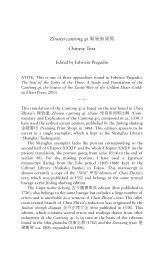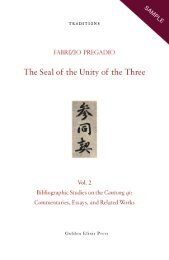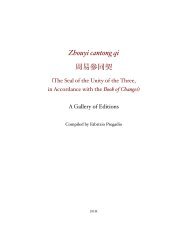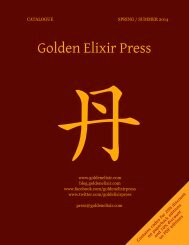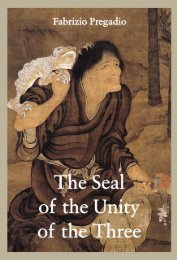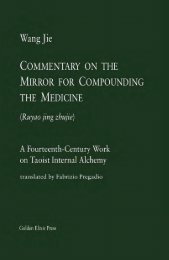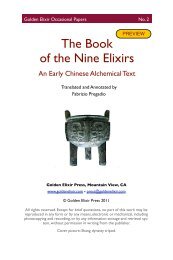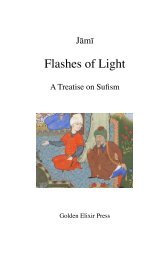Robinet, The World Upside Down: Essays on ... - The Golden Elixir
Robinet, The World Upside Down: Essays on ... - The Golden Elixir
Robinet, The World Upside Down: Essays on ... - The Golden Elixir
- No tags were found...
You also want an ePaper? Increase the reach of your titles
YUMPU automatically turns print PDFs into web optimized ePapers that Google loves.
Works QuotedLi Yuanguo . Daojiao qig<strong>on</strong>g yangshengxue 养 [Taoistqig<strong>on</strong>g and the Nourishment of Life]. Chengdu: Sichuan sheng ShehuiKexueyuan chubanshe, 1988.Needham, Joseph. Science and Civilisati<strong>on</strong> in China, vol. V: Chemistry andChemical Technology, part 5: Spagyrical Discovery and Inventi<strong>on</strong>: PhysiologicalAlchemy. With the collaborati<strong>on</strong> of Lu Gwei-Djen. Cambridge:Cambridge University Press, 1983.<str<strong>on</strong>g>Robinet</str<strong>on</strong>g>, Isabelle. Introducti<strong>on</strong> à l’alchimie intérieure taoïste: De l’unité et dela multiplicité. Paris: Le Cerf, 1994.———. La révélati<strong>on</strong> du Shangqing dans l’histoire du taoïsme. 2 vols. Paris:École Française d’Extrême-Orient, 1984.———. Les commentaires du Tao tö king jusqu’au VIIe siècle. Paris: Collègede France, Institut des Hautes Études Chinoises, 1977.———. “<str<strong>on</strong>g>The</str<strong>on</strong>g> Place and Meaning of the Noti<strong>on</strong> of Taiji in Taoist Sourcesprior to the Ming Dynasty.” History of Religi<strong>on</strong>s 29 (1990): 373–411.Schipper, Kristofer M., and Wang Hsiu-huei. 1986. “Progressive and RegressiveTime Cycles in Taoist Ritual.” In J.T. Fraser, N. Lawrence, and F.C.Haber, eds., Time, Science, and Society in China and the West, 185–205.Amherst: University of Massachusetts Press, 1986.Seidel, Anna. La divinisati<strong>on</strong> de Lao tseu dans le Taoïsme des Han. Paris:École Française d’Extrême-Orient, 1969.Sivin, Nathan. “<str<strong>on</strong>g>The</str<strong>on</strong>g> <str<strong>on</strong>g>The</str<strong>on</strong>g>oretical Background of <strong>Elixir</strong> Alchemy.” In JosephNeedham, Science and Civilisati<strong>on</strong> in China, vol. V: Chemistry andChemical Technology, part 4: Spagyrical Discovery and Inventi<strong>on</strong>: Apparatus,<str<strong>on</strong>g>The</str<strong>on</strong>g>ories and Gifts, 210–305. Cambridge: Cambridge UniversityPress.Solom<strong>on</strong>, Bernard. “‘One is no Number’ in China and the West.” HarvardJournal of Asiatic Studies 17 (1954): 253–60.Strickmann, Michel. “On the Alchemy of T’ao Hung-ching.” In HolmesWelch and Anna Seidel, eds., Facets of Taoism: <str<strong>on</strong>g>Essays</str<strong>on</strong>g> in ChineseReligi<strong>on</strong>, 123–92. New Haven and L<strong>on</strong>d<strong>on</strong>: Yale University Press.Vandermeersch, Lé<strong>on</strong>. Wangdao ou la voie royale. 2 vols. Paris: Publicati<strong>on</strong>sde l’EFEO, 1980.Wats<strong>on</strong>, Burt<strong>on</strong>. <str<strong>on</strong>g>The</str<strong>on</strong>g> Complete Works of Chuang Tzu. New York: ColumbiaUniversity Press, 1968.Zürcher, Erik. “Buddhist Influence <strong>on</strong> Early Taoism: A Survey of ScripturalEvidence.” T’oung Pao 66 (1980): 84–147.129



